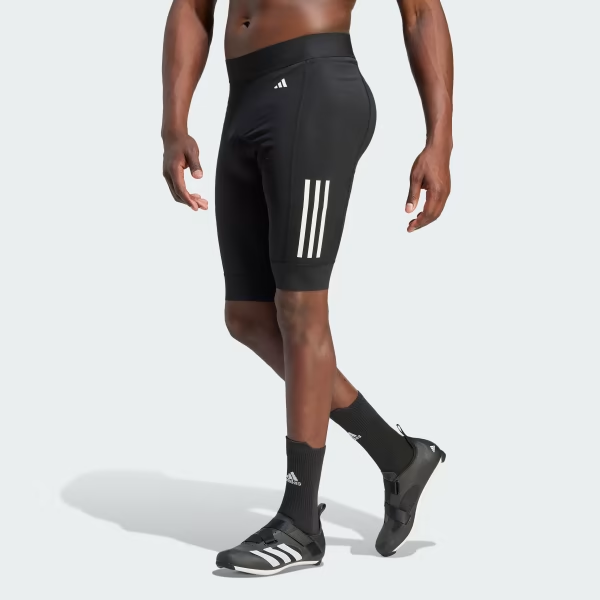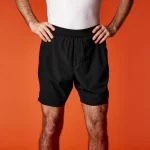Cycling is a fantastic activity that offers a multitude of benefits – fresh air, exercise, and a chance to explore. But for many men, especially beginners, discomfort in the saddle can be a major deterrent. This is where men’s cycling shorts come in – a specialized piece of equipment designed to make your rides more enjoyable and efficient.
So, why are cycling shorts different from regular shorts? The key difference lies in the padding, also known as a chamois. This insert, typically made from high-density foam or gel, sits between your body and the saddle. It absorbs shock and reduces friction, preventing chafing and soreness – common issues that can plague even short rides in regular clothing.
Types of Men’s Cycling Shorts
There are two main types of men’s cycling shorts: liners and bibs. Liners are essentially short tights with a chamois. They are worn underneath regular cycling shorts or baggier mountain bike shorts. Bibs, on the other hand, have the chamois integrated into a short with suspenders that go over the shoulders.

Liners vs. Bibs: Choosing the Right Option
Both liners and bibs offer excellent comfort and support, but there are some key differences to consider:
- Fit: Liners rely on the outer layer for a snug fit. Bibs, with their suspenders, provide a more secure and comfortable fit, especially on longer rides.
- Ease of Use: Liners can be easier to put on and take off, particularly during mid-ride bathroom breaks. However, bibs eliminate the need to adjust shorts while riding.
- Temperature Regulation: Bibs can be warmer than liners due to the additional fabric covering the upper body. This might be a factor in hot weather.
Ultimately, the best choice comes down to personal preference. Many cyclists opt to have both liners and bibs in their wardrobe for different riding conditions and durations.

Features to Look for in Men’s Cycling Shorts
When shopping for men’s cycling shorts, consider these features:
- Chamois Quality: This is the most crucial element. Look for a multi-density chamois that provides targeted support in key areas. Consider the length of your rides when choosing a chamois thickness – thicker padding is better for longer distances.
- Material: Breathable and moisture-wicking fabrics are essential for comfort. Synthetic materials like polyester and nylon are common choices.
- Seams: Flatlock seams minimize chafing.
- Grippers: Leg grippers with silicone prevent the shorts from riding up while pedaling.
- Additional Features: Some shorts offer features like reflective accents for increased visibility, storage pockets, and antibacterial treatments.

Finding the Perfect Fit
A well-fitting pair of cycling shorts is crucial for maximizing comfort and performance. Here are some tips:
- Size: Don’t be afraid to try different sizes to find the perfect fit. Cycling shorts should be snug but not constricting.
- Length: Liners should be long enough to stay tucked in throughout your ride. Bibs come in various lengths, with shorter options offering a more race-oriented fit.
- Chamois Placement: The chamois should sit directly on your sit bones when you’re in the riding position.
Caring for Your Men’s Cycling Shorts
Proper care extends the lifespan of your cycling shorts and maintains their performance. Here’s how:
- Washing: Follow the care instructions on the label. Most cycling shorts can be machine-washed on a gentle cycle with mild detergent. Avoid using fabric softeners, which can damage the wicking properties.
- Drying: Air-drying is preferred to preserve the elasticity of the fabric. Avoid using high heat settings in the dryer.

Beyond the Basics: Advanced Considerations
Once you’ve mastered the fundamentals, you can explore more advanced features:
- Body Geometry Fit: Some brands offer shorts designed specifically for different body geometries, taking into account anatomical variations.
- Chamois Shape: The shape of the chamois can cater to specific needs. For example, some are designed for aggressive riding positions, while others prioritize comfort for more upright postures.
Layering Like a Pro: Mastering Comfort in Every Climate
The beauty of layering lies in its versatility. By strategically combining different clothing items, you can adapt to a wide range of weather conditions, from crisp mornings to unexpected downpours. Let’s delve into the world of layering, exploring options for different climates and offering budgeting tips to help you build a functional wardrobe.
The Layering System:
Think of layering as a three-part system:
- Base Layer: This wicks moisture away from your skin, keeping you dry and comfortable. Choose synthetic fabrics like polyester or merino wool for optimal performance.
- Mid Layer (Optional): This layer provides insulation, trapping warmth. Options include fleece jackets, lightweight down vests, or even a simple long-sleeved shirt.
- Outer Shell: This protects you from the elements – wind, rain, or snow. Look for breathable, waterproof materials like Gore-Tex or similar technologies.
Adapting to Different Climates:
- Mild Weather (50°F – 70°F): A lightweight base layer paired with a windbreaker or a light jacket is ideal.
- Cool Weather (30°F – 50°F): Add a mid-layer like a fleece jacket or a light sweater over your base layer. Top it off with a windproof or water-resistant shell.
- Cold Weather (Below 30°F): Opt for a thicker base layer, a warm mid-layer like a down jacket, and a heavy-duty outer shell.
Price Ranges and Budgeting Tips:
Building a complete layering system doesn’t have to break the bank. Here’s how to be budget-conscious:
- Prioritize: Invest in high-quality base layers and a good outer shell. These are the workhorses of your layering system and will get the most use.
- Shop Around: Compare prices across different stores, both online and brick-and-mortar. Look for sales and clearance deals.
- Consider Versatile Pieces: Choose mid-layers that can be worn on their own or as part of your layering system.
- Think Long-Term: High-quality garments might cost more upfront, but they will last longer and offer better performance than budget options.
- Explore Used Gear: Check out online marketplaces or consignment shops for gently used outdoor gear. You can find great deals on quality items.
- Layering Hacks: Don’t underestimate the power of accessories! A beanie, gloves, and a neck gaiter can significantly increase warmth without a hefty price tag.

Give suggestions on finding the best value for money
Finding cycling shorts that balance quality, comfort, and affordability can be tricky. Here are some tips to get the best value for your money:
- Set a Budget: Determine how much you’re comfortable spending upfront. This will help you narrow down your options.
- Prioritize Features: Consider which features are most important to you. For example, if you only plan on short rides, a thinner chamois might suffice.
- Shop Online – But Compare Prices: Online retailers often offer competitive prices, but be sure to compare prices across different websites before making a purchase. Look for reputable online cycling stores with good return policies.
- Consider Outlet Stores and Sales: Many cycling brands have outlet stores or run seasonal sales. You can score significant discounts on past-season models that still offer excellent performance.
- Look for Reputable Brands: While lesser-known brands might offer lower prices, sticking with established cycling brands often guarantees better quality materials, construction, and chamois design.
- Read Reviews: Online reviews from other cyclists can provide valuable insights into the fit, comfort, and durability of different shorts.
- Don’t Discount Used Gear: Consider buying gently used cycling shorts from online marketplaces or local cycling clubs. This can be a great way to find high-quality shorts at a fraction of the retail price. However, be sure to inspect the shorts carefully for signs of wear and tear before purchasing.
Men’s cycling shorts are an investment in your cycling enjoyment. By understanding the different types, features, and fit considerations, you can choose the perfect pair that will keep you comfortable and focused on the ride ahead. So, don’t let saddle discomfort hold you back – explore the world of cycling shorts and experience the difference they can make on your next adventure.


